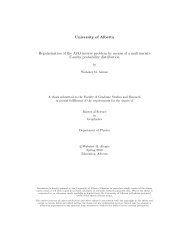Soner Bekleric Title of Thesis: Nonlinear Prediction via Volterra Ser
Soner Bekleric Title of Thesis: Nonlinear Prediction via Volterra Ser
Soner Bekleric Title of Thesis: Nonlinear Prediction via Volterra Ser
You also want an ePaper? Increase the reach of your titles
YUMPU automatically turns print PDFs into web optimized ePapers that Google loves.
2.3. LINEAR PREDICTION 12<br />
In my thesis I have adopted the least squares approach to estimate the coef-<br />
ficients <strong>of</strong> linear and non-linear prediction systems but bear in mind that other<br />
method (at least for the linear prediction problem) are also plausible. In the follow-<br />
ing section I will discuss three methods to estimate the coefficients a(i), i = 1 . . . p<br />
from the data x(n): the Yule-Walker method, Burg’s algorithm, and the least<br />
squares approach.<br />
2.3.1 Forward and backward prediction<br />
Off-line processing allows computation <strong>of</strong> forward and backward prediction oper-<br />
ators. In other words, I can use past samples <strong>of</strong> data to predict future samples<br />
and/or I can use future samples <strong>of</strong> data to predict past samples. This allows us to<br />
formulate a problem with two systems <strong>of</strong> equations. One for forward prediction,<br />
and, the other for backward prediction,<br />
x f p<br />
n = a<br />
i=1<br />
f<br />
i xn−i + εn, (2.12)<br />
x b p<br />
n = a<br />
i=1<br />
b ixn+i + εn . (2.13)<br />
2.3.2 Estimating AR coefficients <strong>via</strong> Yule-Walker Equations<br />
I can write equation (2.6) as follows<br />
X(z) = E(z)<br />
, (2.14)<br />
A(z)<br />
and the autocorrelation in the z domain (Ulrych and Sacchi, 2005) is









